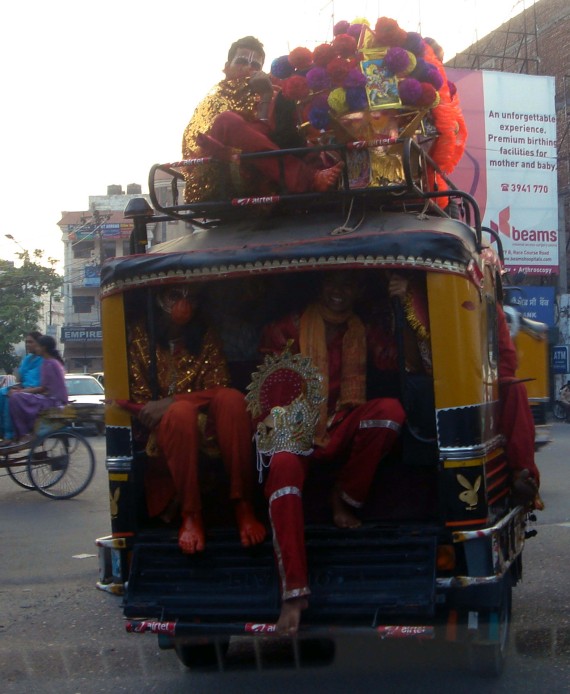
WORLD FAMOUS LANGOOR WALA MELA IN AMRITSAR
RASHMI TALWAR , AMRITSAR
October 2011—-
‘Amritsar’ conjures up images of the glistening ‘Golden Temple’ but few are aware that the holy city of Amritsar is also “world famous” for the “langoorwala Mela”.
What “Durga Puja” is to West Bengal and “Dandiya celebrations” are to Gujarat, the Langoorwala Mela is to the Holy City of Amritsar.
Every year on the occasion of the Navratras, thousands from across the country and abroad arrive at the ancient “Bara Hanuman Prachin Mandir” at Durgiana Temple here to take part in the internationally famous nine-day Mela to make a wish for a child or for thanksgiving.
The unique mela that begins on the auspicious occasion of Navratras (9-Holy Days) during the onset of winter months close to Diwali and Dussehra festivals is a rare feast for the eyes in the Holy city that sees children dressed as “langoors” dancing to the tune of drums in a procession passing through different parts of the city.
More than 2000 langoor costumes are sold annually while many outfits are given on rent due to their cost factor say temple authorities.
Many childless devotees, irrespective of ‘religion’ or caste, don the garb of langoor to seek Lord Hanuman’s blessings for the birth of a child, while many children can be seen wearing the langoor dress to show their gratitude towards the Almighty
In bright red silver-striped outfits, with silver and golden trimmings, conical caps, faces smeared with fuller’s earth and make up like langoors complete with long tails and silver-coloured staffs, children dressed as langoors dance to drum beats for all nine days of Navratras. Some even don the masks of monkeys and langoors and color their legs and arms
The temple boasts of a “rare” idol of Lord Hanuman in sitting position. Except for Hanuman Gadri, Ayodhya, such posture of the idol of Lord Hanuman is believed to exist nowhere in the world.
According to legend, in the epic Ramayana, twin sons of Lord Rama – Luv and Kush (Lahore and Kasur in Pakistan were named after them, respectively) — who lived in exile with their mother, Sita Mata at Ram Tirath (near Amritsar ) captured the ‘Ashwamedha horse’ let loose after “Ashwamedha Yajna” performed by Lord Rama to stake his claim over the territories where the Royal horse set afoot.
Lord Hanuman, who came to defend the captured horse from the two young sons of Lord Ram, was taken prisoner by the twins and tied to a Banyan tree which is believed to be the same tree located in the Durgiana Mandir.
Eons Later, a temple was built at this place, to commemorate this incident. Childless couples believing auspicious spirits around this tree lovingly tie a red sacred thread or ‘mauli’ around the majestic bark of this is ancient banyan tree when seeking the boon of a child.
Interestingly, an eighty-year-old and a few months old baby alike can be seen dressed as langoors to fulfill the vows of as pledged by their parents or grandparents.
A strict regime of customs is followed by devotees during the nine-days of Navratras . On their part, the parents or a guardian sleeps on the floor, observes fast, avoids footwear, eats vegetarian food uncut with knife and recite verses from Ramayana during the entire 9-day period.
The “langoors” on their part also follow customs and remain bare-foot all the 9- days and sleep on the floor. On the first day, they bring some sweets, coconut and flowers after seeking blessings from the Pandit or Head priest.
The mela concludes on Dussehra festival when “langoors” finally take off their langoor outfits near the banyan tree.
The childless mothers gifted with a child, untie the thread on the ancient tree on the fulfillment of their wish. According to a popular legend, the unique festival has been celebrated for centuries.












Posted by tandoori chicken in amritsar on January 16, 2017 at 5:22 PM
Makhan Fish and Chicken Shop the Original Makhan in Amritsar was started by S.
Mohinder Singh Makhan (Real Owner Of Makhan Fish) in March, 1991
with a small Khokha (stall) that was located at
Lawrence Road, Amritsar.
LikeLike